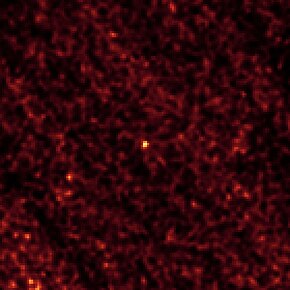
Back 2011 MD Arabic 2011 MD Catalan 2011 MD German 2011 MD Spanish ۲۱۱ امدی Persian 2011 MD French 2011 MD Croatian 2011 MD ID 2011 MD Italian 2011 MD Japanese
 2011 MD imaged by Spitzer in February 2014 | |
| Discovery[1][2] | |
|---|---|
| Discovered by | LINEAR |
| Discovery site | Lincoln Lab's ETS |
| Discovery date | 2011 June 22 (first observed only) |
| Designations | |
| 2011 MD | |
| NEO · Apollo[1] · Amor[3] | |
| Orbital characteristics[1] | |
| Epoch 13 July 2011 (JD 2455755.5) | |
| Uncertainty parameter 2[1] · 0[3] | |
| Observation arc | 2.65 yr (967 days) |
| Aphelion | 1.1031 AU |
| Perihelion | 1.0161 AU |
| 1.0596 AU | |
| Eccentricity | 0.0411 |
| 1.09 yr (398 days) | |
| 11.051° | |
| 0° 54m 13.32s / day | |
| Inclination | 2.5624° |
| 273.96° | |
| 4.6748° | |
| Earth MOID | 0.0003 AU (0.1 LD) |
| Physical characteristics | |
| 6 m (estimate)[4][5] | |
Mean density | 1 g/cm3 (est. rubble pile)[4] |
| 0.1937 h[1] | |
| 0.3[5] | |
| 28.0[1] | |
2011 MD is a bright micro-asteroid, classified as near-Earth object of the Apollo and Amor group, respectively.[1][3] On 27 June 2011, at around 17:00 UTC (13:00 EDT), the object passed exceptionally close to Earth's surface at a distance of approximately 12,000 kilometers (7,500 mi), roughly the diameter of the Earth.[6][7][8]
- ^ a b c d e f g Cite error: The named reference
jpldatawas invoked but never defined (see the help page). - ^ Cite error: The named reference
MPEC2011-M23was invoked but never defined (see the help page). - ^ a b c Cite error: The named reference
MPC-objectwas invoked but never defined (see the help page). - ^ a b Cite error: The named reference
NASA2014-195was invoked but never defined (see the help page). - ^ a b Cite error: The named reference
Mommert2014was invoked but never defined (see the help page). - ^ Cite error: The named reference
NASA-newswas invoked but never defined (see the help page). - ^ Cite error: The named reference
SKY1was invoked but never defined (see the help page). - ^ Cite error: The named reference
NatGeowas invoked but never defined (see the help page).